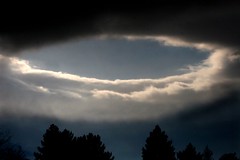 Image by arbyreed via Flickr
Image by arbyreed via FlickrAre we making Holes in Heaven? HAARP (High Frequency Active Auroral Research Program) is a controversial high frequency radio transmitter, or "ioniospheric heater," which is believed to be descended from the works of Nikola Tesla and is jointly funded by the US Air Force, the US Navy, the University of Alaska and the Defense Advanced Research Projects Agency (DARPA) in remote Gakona, Alaska.
Built by BAE Advanced Technologies (BAEAT), its purpose is to analyze the ionosphere and investigate the potential for developing ionospheric enhancement technology for radio communications and surveillance purposes.
The most prominent instrument at the HAARP Station is the Ionospheric Research Instrument (IRI), a high power radio frequency transmitter facility operating in the high frequency (HF) band. The IRI is used to temporarily excite a limited area of the ionosphere. Other instruments, such as a VHF and a UHF radar, a fluxgate magnetometer, a digisonde and an induction magnetometer, are used to study the physical processes that occur in the excited region.
Work on the HAARP Station began in 1993. The current working IRI was completed in 2007, and its prime contractor was BAE Systems Advanced Technologies.
As of 2008, HAARP had incurred around $250 million in tax-funded construction and operating costs. HAARP has also been blamed by conspiracy theorists for a range of events, including numerous natural disasters.
Visit the official "Holes in Heaven?" website HERE.
Using HAARP, the military can focus a billion-watt pulsed radio beam into our upper atmosphere, ostensibly for ionospheric research. This procedure will form extremely low frequency waves and send them back to the Earth, enhancing communications with submarines and allowing us to "see" into the Earth, detecting anything from oil reserves to underground missile silos.
However, several researchers claim HAARP poses many dangers, including blowing thirty-mile holes in the Earth's upper atmosphere. They also warn of possible disruption of the subtle magnetic energies of our Earth and ourselves.
Holes in Heaven? is a prime example of grassroots filmmaking by producer Paula Randol-Smith and Emmy-winning director Wendy Robbins. Narrated by Martin Sheen, the film, investigates HAARP, its history and implications, and examines the dangers and benefits of high and low frequencies and of electromagnetic technology.
Among the many scientists interviewed are Dr. Bernard Eastlund, whose original patents are the reputed blueprints for HAARP, Project Director Dr. John Heckscher, and Dr. Nick Begich and Jeane Manning authors of Angeles Don't Play This HAARP.
Holes in Heaven? strives to give a fair and accurate appraisal of HAARP, and brings before the public, vital information about a project which could have a dramatic effect upon our entire world!


No comments:
Post a Comment